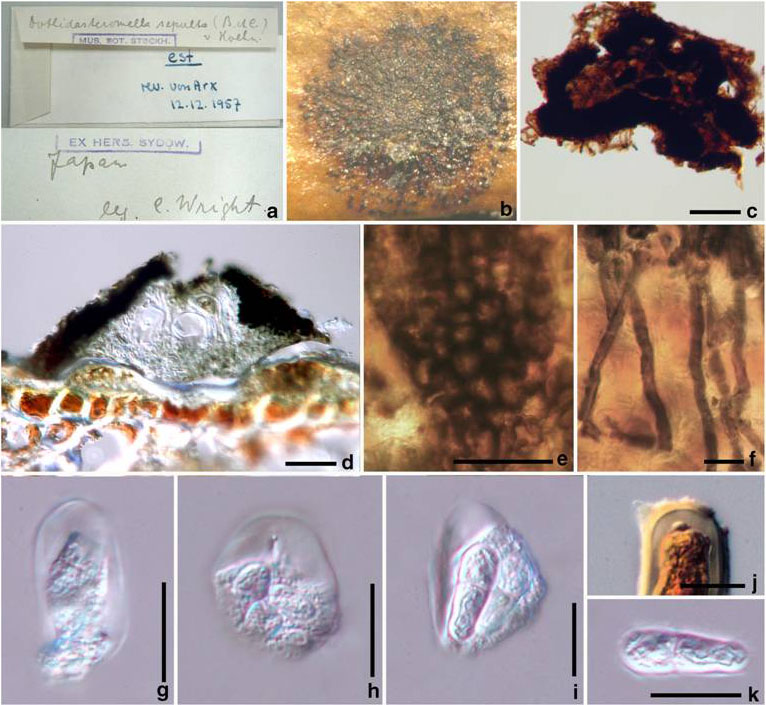Dothidasteromella sepulta (Berk. & M.A. Curtis) Höhn., Sber. Akad. Wiss. Wien, Math.-naturw. Kl., Abt. 1 119: 421
≡ Asterina sepulta Berk.& M.A. Curtis, Proc. Amer. Acad. Arts & Sci. 4: 128 (1860) [1858] ≡ Dothidasteris sepulta (Höhn.) Clem. & Shear, Gen. Fung. (Minneapolis): 298 (1931)
Type: K 163345, holotype; FH, isotype; S-F56756, isotype.
Epiphytes on the upper surface of Cinnamomum, forming large blackened circular areas 1.2–2 mm. Superficial hyphae 2–4μm diam (x = 3μm, n=10), brown to dark brown, difficult to remove from the surface of host. Sexual state: Thyriothecia 158–172 diam×59–72 high μm (x= 169×65μm, n=5), superficial, erumpent from mycelia mass, solitary or gregarious, globose to subglobose,more or less carbonaceous, difficult to remove from the host surface, opening by linear or sometimes Y-shape at the central of thyriothecium. Peridium 19–27μm diam (x = 25μm, n=10), comprising 2-layers, outer layer dark brown, inner layer hyaline, comprising cells of textura angularis. Hamathecium lacking pseudoparaphyses. Asci 23–28×14–19μm (x = 25×16μm, n=10), 4–8-spored, bitunicate, fissitunicate, oblong or subglobose, short pedicellate, or pedicel lacking, apical region of asci usually with a thick opaque region and ocular chamber. Ascospores 14–17× 6–8 μm (x = 15×7μm, n=10), overlapping bi-seriate, hyaline, ellipsoid to fusoid, 1-septate, slightly constricted at the septum, upper cell broader and shorter than lower cell, verrucose. Asexual state: Unknown.
Material examined: JAPAN, on the leaf of Cinnamomum japonicum, collected by C.Wrigler 167, Herbarium of the US North Pacific Exploring Expedition 1853–1856, no 414 (K 163345, holotype); Ibid. (FH, isotype), Ibid. (S-F56756, isotype).
Fig. 1 Dothidasteromella sepulta (S-F56756, isotype). a Herbarium packet. b Thallus on substrate. c Thyriothecium when viewed in squash mount showing ostiole. d Section though thyriothecium. e Upper wall of thyriothecia. f Superficial hyphae. g Immature ascus. h, i Mature asci. j Ocular chamber stained in Melzer’s reagent. k Ascospore. Scale bars: c= 50μm, d, e=20μm, f–k=10μm

